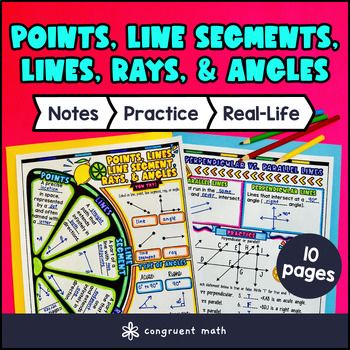Want more ideas and freebies?
Get my free resource library with digital & print activities—plus tips over email.
Join for Free Resources →
$4.25
Ever wondered how to teach points, lines, line segments, rays, angles, and parallel and perpendicular lines in an engaging way to your 4th grade students?
In this lesson plan, students will learn about these fundamental geometry concepts and their real-life applications. Through artistic, interactive guided notes, checks for understanding, a color-by-code activity, and a maze worksheet, students will gain a comprehensive understanding of these topics.
The lesson culminates with a real-life example that explores how these geometric concepts are used in everyday situations, helping students see the relevance of math beyond the classroom.

$4.25
After this lesson, students will be able to:
Before this lesson, students should be familiar with:
As a hook, ask students if they have ever noticed the types of lines and angles around them, such as the edges of books, the corners of rooms, or roads crossing each other. How do they think these lines and angles help us in everyday life? Refer to the last page of the guided notes as well as the FAQs below for ideas.
Use the first page of the guided notes to introduce points, lines, line segments, and rays. Walk through the definitions and examples of each, emphasizing that a point represents a location, a line extends infinitely in both directions, a line segment has two endpoints, and a ray has one endpoint and extends infinitely in one direction. Use the doodle space to help students visualize and differentiate these concepts. Refer to the FAQ below for a walkthrough on this, as well as ideas on how to respond to common student questions, such as confusion between rays and line segments.
Use the second page of the guided notes to introduce angles and their types: acute, right, obtuse, and straight angles. Explain how angles are formed by two rays with a common endpoint and how to identify the different angle types using degree measures or visual clues. Guide students to draw examples and label types of angles in their notes. Refer to the FAQ below for ideas on how to address questions about distinguishing similar angle types or measuring angles.
Use the third page of the guided notes to introduce parallel and perpendicular lines. Define parallel lines as lines that never intersect and are always the same distance apart, and perpendicular lines as lines that intersect to form right angles. Show examples of each and encourage students to doodle real-world examples they can think of. Refer to the FAQ below for a walkthrough and strategies on clarifying common misconceptions, such as confusing intersecting lines that are not perpendicular.
Based on student responses during checks for understanding embedded in each page, reteach concepts that students need extra help with. If your class has a wide range of proficiency levels, you can pull out students for reteaching sessions and have more advanced students begin preliminary work on the practice exercises included later in the resource.
Have students practice identifying and drawing points, lines, line segments, rays, and angles using the color-by-code worksheet. Walk around to answer student questions.
Fast finishers can dive into the maze and problem set activity for extra practice. You can assign it as homework for the remainder of the class.
Bring the class back together, and introduce the concept of how points, lines, line segments, rays, and angles are used in real-world contexts such as architecture, road design, and art. Show students examples of parallel and perpendicular lines in city streets and buildings, and explain how understanding angles helps engineers and designers create safe and functional structures. Refer to the FAQ for more ideas on how to teach it!
If you’re looking for digital practice for points, lines, line segments, rays, angles, and parallel & perpendicular lines, try my Pixel Art activities in Google Sheets. Every answer is automatically checked, and correct answers unlock parts of a mystery picture. It’s incredibly fun, and a powerful tool for differentiation.
Here’s 1 activity to explore:
A point in geometry represents a precise location in space and has no size, shape, or dimension.
A line extends infinitely in both directions with no endpoints, while a line segment has two endpoints and is finite in length.
A ray starts at one endpoint and extends infinitely in one direction, like a half-line.
Angles are identified based on their measure:Acute angles are less than 90°, Right angles are exactly 90°, Obtuse angles are between 90° and 180°, and Straight angles are exactly 180°.
Parallel lines are two lines in the same plane that never intersect, no matter how far they are extended.
Perpendicular lines are two lines that intersect at a right angle (90°).
To draw an acute angle, create two rays that share a common endpoint and measure an angle less than 90 degrees between them.
Understanding lines and angles is essential because:They form the basis for many geometric shapes, help solve real-world problems like architecture and engineering, and improve spatial reasoning skills.
Parallel and perpendicular lines differ in how they interact:Parallel lines never intersect and stay the same distance apart, while perpendicular lines intersect at right angles (90°).
Real-life examples include:railroad tracks (parallel), street intersections (perpendicular), building structures, and various designs in art and architecture.
Get my free resource library with digital & print activities—plus tips over email.
Join for Free Resources →